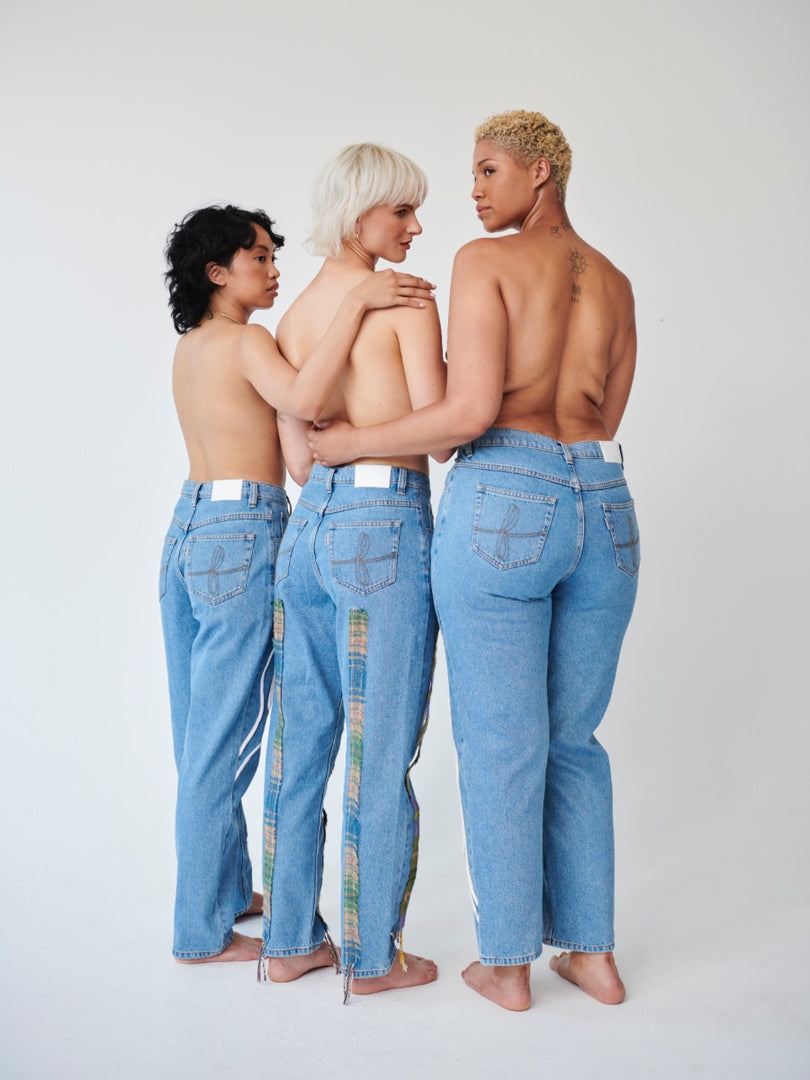The term “Buy Less, Choose Well, Make it Last” was first coined by the iconic fashion designer Vivienne Westwood and has since come to represent a growing movement, where considering what you buy and the story behind your purchase is just as important as the purchase itself. If we can take away a positive from the past year, it would be that it has forced us to reexamine our values, take the time to research our purchases and evaluate what we really need.
"It has forced us to reexamine our values, take the time to research our purchases and evaluate what we really need."
Buy Less
It is vital we tackle the growing amount of waste generated by the fashion industry. Since 2000 the number of garments produced annually has doubled and consumers keep their clothing for half the amount of time they did 15 years ago (McKinsey). We have been bombarded with the temptation of novelty through the advent of online shopping and social media, while the fast paced nature of new collection releases has led to us expect constant newness. It is clear that we can no longer continue on this trajectory as we exceed the limits of the earth through our over-consumption.
To address this over-consumption culture, a recentering of consumer and business values is needed . A connection to the human element of clothing production is essential to open up the process and convey the true cost, whether that is the wage someone receives , labour conditions or resource pollution adversely affecting the communities where factories are based. Understanding the journey behind a piece of clothing ( which is often a long one) is crucial to assigning clothing the value it deserves.
Slow Fashion promotes a considered approach to consumption where a focus on quality and the ethics involved with the production of a garment are at the forefront and where products are not developed at the expense of the welfare of people and the planet. We think this is a great approach to follow and aligns with our values at Fanfare.
“Consumer demand can revolutionise the way fashion works as an industry. If everyone started to question the way we consume, we would see a radically different fashion paradigm.” —
Carry Somers and cofounder of Fashion Revolution
Quality
A recent McKinsey survey found that quality and purpose are most important for consumers when trying a new brand, which may indicate a changing tide in consumer culture.
If we want clothes to last they need to be made from durable materials. Picking natural materials like Cotton, Linen and Tencel means that they will last longer, while these fibres are biodegradable and also possess positive qualities such as breathability. .
It may not always be the case that expensive brands equate to good quality, but usually spending £10 on a top doesn’t mean it has been made to the best standards. Investing more money in a higher quality and better made piece will ensure it lasts for longer and the added expense will be accounted for in the extra wears you get out of it. Picking timeless pieces, that you are able to style with different elements of your wardrobe will also ensure that you get the maximum use out of a garment.
Choose Well
To choose well, consumers need accurate and clear information on the sustainability of the brands they choose to buy. Historically, the fashion industry has been secretive about their supply chains and labour practices, but this is slowly changing.
Along with supporting emerging designers, a benefit of shopping small is having more knowledge of where your clothes have come from. Generally, smaller labels, will be able to have greater control regarding their supply chains and manufacturing practices and offer more transparency regarding their sustainability strategies. A good indicator of an ethical business is how a brand gives back to the community and engages with the people involved in their supply chain.
Apps such as Good On You, rate brands on issues such as their labour policies, resource use and waste management. This can be a helpful and quick way for consumers to receive an insight into the impact their purchases are having, rather than having to wade through a lot of research themselves.
Be Aware Of
Green Washing
Brands need to start somewhere and it’s great that the conversation of sustainability is now on the agenda of fashion companies. Over the past few years, many high street retailers have released sustainable lines with fabrics that include a percentage of recycled material or organic cotton. While this is a start, it can’t be declared truly sustainable production and customers are demanding accountability. It is not enough for brands to only have sustainable lines as an add-on or as a PR statement anymore. To fully commit to making real change, brands need to analyse their main product offering and aim to phase out non-sustainable products as a matter of urgency. Paradoxically, the sheer amount of clothing large brands produce can cancel out any smaller sustainability initiatives. It is key that they mitigate their impact through reducing quantities.
Thoughtful Consideration
It has become so easy to click and add another piece of clothing to your basket when shopping online, but taking the time to stop and consider why you are buying and doing some extra research can avoid impulse buys. This could involve making lists or mood boards of your favourite items to see if you already have something similar, or whether they will go well with existing pieces. By saving items and coming back to them a week or month later, you can see if you still have the same desire to purchase them as you did originally. The #30wears challenge championed by Livia Firth ( Founder of Eco-Age) is a great incentive to wear your clothes more, but also, when buying new to consider whether you could get 30 wears out of a garment. If the answer is no, it might be time to reconsider that purchase.
Make it Last
Aftercare is often overlooked, but it is an easy change we can all make to reducing our environmental impact. How you care for a garment accounts for around 30 per cent of a garment’s total carbon footprint (Vogue Business) Actions such as energy efficient washing at 30 degrees, washing clothes less and air drying will all extend the lifetime of your clothes and reduce their carbon impact.
Choose Second Hand
The process of making new clothes is a carbon and water intensive process. Making new fabric involves the extraction of precious natural resources for natural fibres production and the use of oil to make polyester fibres. Disposing of our clothing pollutes massively, as huge quantities of clothing ends up in landfill. In the UK, an estimated £140 million worth (around 350,000 tonnes) ends up in landfill every year (WRAP). Clothes swaps, upcycling, renting and buying second-hand, all contribute to extending the lifecycle impact of a piece of clothing and remove the negative effects of making a piece from scratch. Plus it can be really rewarding to discover a hidden gem, whether that is a vintage piece, a borrowed designer dress or something upon which you have put your own twist by up-cycling.
It’s easy for conversations about sustainability to get bogged down in negativity but this mantra isn’t about quitting shopping. It’s really about loving your clothes, creating a connection and using your purchasing power for good. We hope that some of these suggestions will help you on your slow fashion journey, and that the term “Buy Less, Choose Well, Make it Last” resonates with you as much as it does with us.



